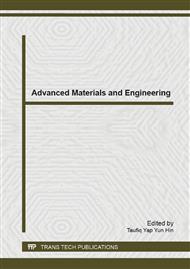[1]
J. Zhang, R.D.K. Misra, Magnetic drug-targeting carrier encapsulated with thermosensitive smart polymer: Core–shell nanoparticle carrier and drug release response, Acta Biomaterialia, 3 (2007) 838-850.
DOI: 10.1016/j.actbio.2007.05.011
Google Scholar
[2]
G. Filipcsei, I. Csetneki, A. Szilágyi, M. Zrínyi, Magnetic field-responsive smart polymer composites, Advances in Polymer Science, 206(2007)137-189.
DOI: 10.1007/12_2006_104
Google Scholar
[3]
M. S. Yavuz, Y. Cheng, J. Chen et al, Gold nanocages covered by smart polymers for controlled release with near-infrared light, Nature Materials, 8 (2009)935-939.
DOI: 10.1038/nmat2564
Google Scholar
[4]
K. Al-Tahami, J. Singh, Smart polymer based delivery systems for peptides and proteins, Recent Patents on Drug Delivery & Formulation, 1(2007) 65-71.
DOI: 10.2174/187221107779814113
Google Scholar
[5]
J. Yang, Cur. Viscoelastic wormlike micelles and their applications, Opin. Colloid Interface Sci., 7(2002) 276-281.
Google Scholar
[6]
J. Yang, Z. Yang, Y. Lu et al, Rheological properties of zwitterionic wormlike micelle in presence of solvents and cosurfactant at high temperature, J. Dispersion Sci. Tech. 34 (2013) 1124-1129.
DOI: 10.1080/01932691.2012.738125
Google Scholar
[7]
Y. Zhang, Y. Han, Z. Chu, S. He, J. Zhang, Y. Feng, Thermally induced structural transitions from fluids to hydrogels with pH-switchable anionic wormlike micelles, J. Col. Interf Sci, 394 (2013) 319–328.
DOI: 10.1016/j.jcis.2012.11.032
Google Scholar
[8]
R. Kumar , A. M. Ketner, S. R. Raghavan, Nonaqueous photorheological fluids based on light-responsive reverse wormlike micelles, Langmuir, 26 (2010) 5405–5411.
DOI: 10.1021/la903834q
Google Scholar
[9]
A.S. Hoffman, Intelligent, polymers in medicine and biotechnology, Macromolecular Symposia, 98 (1995) 645–664.
DOI: 10.1002/masy.19950980156
Google Scholar
[10]
A.G. Olabi, A. Grunwald, Design and application of magneto-rheological fluid, Materials & Design, 28(2007) 2658-2664.
DOI: 10.1016/j.matdes.2006.10.009
Google Scholar
[11]
Y. Qi, J.L. Zakin, Chemical and rheological characterization of drag-reducing cationic surfactant systems, Ind. Eng. Chem. Res., 41(2002) 6326-6336.
DOI: 10.1021/ie0110484
Google Scholar
[12]
L. Li, H.A. Nasr-El-Din, K.E. Cawiezel. Rheological properties of a new class of viscoelastic surfactant, SPE Prod. Oper, 25(2010) 355-366.
DOI: 10.2118/121716-pa
Google Scholar
[13]
Y.J. Lu, B. Fang, D. Y. Fang et al, Viscoelastic surfactant micelle systems and their rheological properties, Oilfield Chemistry, 20(2003)291-294.
Google Scholar
[14]
N. Gaillard, A. Thomas, C. Favero, Novel associative acrylamide-based polymers for proppant transport in hydraulic fracturing fluids, SPE International Symposium on Oilfield Chemistry, SPE-164072, 8-10 April, The Woodlands, Texas, (2013).
DOI: 10.2118/164072-ms
Google Scholar


